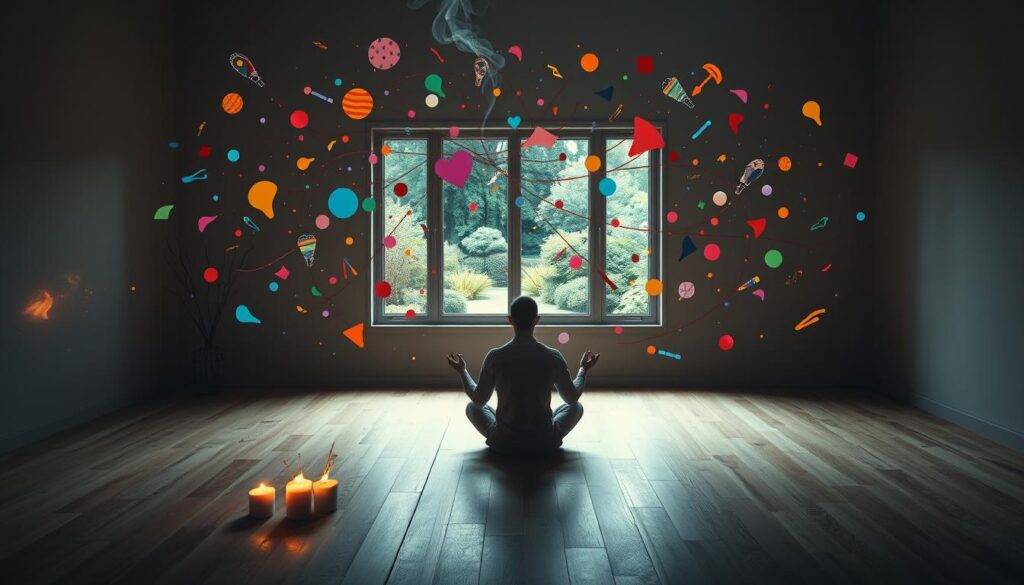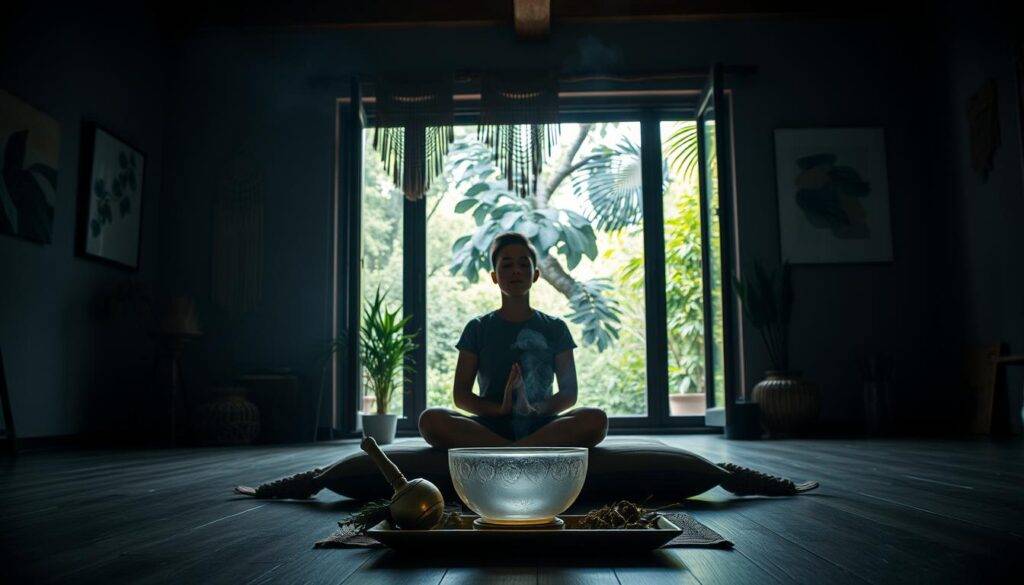“You can’t stop the waves, but you can learn to surf.” — Jon Kabat-Zinn’s words capture the heart of mindfulness: progress, not perfection. If sitting still feels impossible or your thoughts race like untamed horses, you’re not alone. Even seasoned practitioners face hurdles in their meditation practice.
Meditation isn’t about emptying the mind—it’s about cultivating awareness. Many assume a “good session” means zero distractions, but even brief moments of focus build mental clarity over time. Dan Roberts, a meditation coach with 20+ years of experience, emphasizes that proper posture and environment matter as much as intention. Slouching or noisy spaces often amplify restlessness.
Mental chatter? It’s natural. The brain processes thousands of thoughts daily, and meditation works like a filter—not a mute button. Roberts’ “just sit” philosophy encourages embracing discomfort as part of growth. Small, consistent efforts—even five minutes a day—can reshape your relationship with stress.
This article unpacks common roadblocks, from battling distractions to redefining what success looks like. You’ll discover science-backed strategies to anchor your practice and alternative methods if traditional sitting doesn’t click. Let’s turn frustration into fuel.
Key Takeaways
- Meditation focuses on awareness, not eliminating thoughts.
- Physical posture impacts mental clarity during practice.
- Daily consistency trumps session length for progress.
- Distractions are natural and part of the learning process.
- Expert techniques like “just sit” normalize initial struggles.
- Alternative methods exist for traditional meditation resistance.
Understanding the Challenges of Meditation
Meditation often feels like navigating a busy intersection—external chaos meets internal chatter. Whether you’re new to the practice or refining your skills, distractions test your ability to stay anchored. Let’s explore what pulls your focus away and how to work with these moments.

Common Distractions and Environmental Interruptions
Your environment plays a bigger role than you might think. A sudden phone alert, footsteps in the hallway, or a barking dog can fracture concentration. Even subtle sounds—like humming appliances or ticking clocks—disrupt attempts to settle the mind.
Urban settings amplify this challenge. Sirens, construction noise, or loud neighbors become unexpected guests in your practice. Instead of resisting these interruptions, view them as opportunities to practice gentle refocusing. Each time you return to your breath after a distraction, you strengthen mental resilience.
The Role of Overthinking and Mental Noise
Internal distractions often prove trickier than external ones. Thoughts about unfinished tasks, replaying conversations, or worrying about the future crowd the mind. This mental traffic isn’t failure—it’s human nature. Neuroscientists estimate the average person processes over 6,000 thoughts daily.
For example, during a session, you might suddenly remember a grocery list or work email. Label these thoughts as “planning” or “remembering,” then guide your attention back to your body’s sensations. This act of noticing—without judgment—builds mindfulness muscles.
| Distraction Type | Example | Strategy |
|---|---|---|
| External | Doorbell ringing | Pause, acknowledge, resume breath focus |
| Internal | Worrying about deadlines | Visualize thoughts as passing clouds |
| Environmental | Traffic noise | Use sound as an anchor for present-moment awareness |
Remember: Every practitioner faces these hurdles. What matters isn’t eliminating disruptions but learning to dance with them. The next sections will unpack how to transform these challenges into stepping stones for growth.
Why Do Some People Struggle With Meditation?
The human mind resembles a turbulent ocean—waves of thoughts crash against efforts to find calm. Neuroscience reveals this internal friction stems from our biology: stress hormones like cortisol prime the brain for constant alertness. When attempting stillness, this survival mechanism rebels, creating a tug-of-war between mental chatter and intentional focus.

Exploring the Inner Battle Between Stress and Stillness
Harvard researchers found that 47% of beginners report difficulty maintaining focus for three consecutive minutes. This isn’t personal failure—it’s the brain’s default mode network activating. Jon Kabat-Zinn describes this as the “thought stream”, an ever-flowing current of mental activity that shapes our perception.
Anxiety amplifies this challenge. Racing thoughts about work, relationships, or unfinished tasks hijack attention during practice. The goal isn’t to silence these intrusions but to observe them without engagement. Each time you notice distraction and return to your breath, you strengthen neural pathways for sustained awareness.
Consider this: moments of frustration are signposts, not roadblocks. A 2022 UCLA study showed participants who embraced mental noise during meditation developed 30% greater emotional resilience over eight weeks. Struggling signals growth—like muscles burning during exercise.
Later sections will explore techniques to transform this tension into progress. For now, recognize that your practice thrives not in perfection, but in patient redirection. The mind’s restlessness isn’t your enemy—it’s the raw material for building focus.
Identifying Personal Barriers in Meditation
Personal challenges often shape meditation experiences more than external factors. While environmental noise fades, internal barriers—like emotional turbulence or past experiences—can feel immovable. Recognizing these obstacles helps practitioners adapt their approach instead of viewing them as failures.

Stress, Anxiety, and Overwhelm
Intense emotions act like fog over a mirror, clouding mental clarity. A 2023 Johns Hopkins study found 68% of participants reported anxiety disrupted their ability to focus during seated meditation. Racing thoughts about responsibilities or hypothetical scenarios create a loop that feels impossible to pause.
Neuroscientist Dr. Sara Lazar notes: “The mind under stress becomes hypervigilant—it’s biologically wired to scan for threats, not stillness.” This explains why breath-focused practices might initially amplify discomfort for those with chronic worry. Labeling emotions as “anxiety” or “planning” during sessions helps create psychological distance.
Depression, Trauma, and Persistent Negative Thoughts
Past experiences often surface unexpectedly during quiet moments. Trauma survivors may find traditional meditation triggering, as stillness can intensify intrusive memories. UCLA researchers observed that 42% of individuals with depression reported increased self-criticism during early practice stages.
Mindfulness teacher Jon Kabat-Zinn advises: “Meet these moments with radical self-acceptance. If sitting feels unsafe, try walking meditation or mantra repetition instead.” Adjusting techniques reduces pressure while maintaining consistency.
| Barrier Type | Common Triggers | Adaptive Strategy |
|---|---|---|
| Emotional Flooding | Past trauma resurfacing | Grounding techniques: name 5 objects in the room |
| Mental Loops | Repetitive negative thoughts | Use a focal point like a candle flame |
| Physical Restlessness | Anxiety-induced tension | Body scan meditation before seated practice |
Acknowledging personal barriers isn’t defeat—it’s strategic self-awareness. As you identify what makes your practice challenging, you gain power to reshape it. The next section offers concrete methods to navigate both internal and external distractions with grace.
Managing Distractions During Your Meditation Practice
Distractions in meditation act like unexpected guests—they arrive unannounced but don’t need to derail your practice. Learning to work with interruptions builds mental agility. Think of each challenge as a chance to strengthen your focus muscles rather than a sign of failure.

Handling External Sounds and Interruptions
When a doorbell rings or a phone buzzes mid-session:
- Pause gently: Take three deep breaths before responding
- Label the distraction: Whisper “sound” or “interruption” internally
- Reset your anchor: Return attention to breathing patterns
Meditation teacher Sharon Salzberg advises: “The magic isn’t in never getting distracted—it’s in how many times you begin again.” This approach transforms disruptions into training moments.
Refocusing Techniques When the Mind Wanders
For mental chatter that hijacks focus:
- Whisper “thinking” when thoughts arise
- Visualize thoughts as leaves floating down a stream
- Set a 2-minute timer to regroup after major distractions
Guided meditation apps like Insight Timer offer 3-minute refresher sessions perfect for restarting after interruptions. Even brief pauses help rebuild concentration.
Remember: Every return to your breath strengthens neural pathways for sustained awareness. A study in Mindfulness Journal found practitioners who embraced distractions improved focus 40% faster than those resisting them. Your ability to refocus—not eliminate disruptions—defines progress.
Creating a Comfortable Environment for Meditation
Your meditation space acts as the foundation for mental clarity—like constructing a sanctuary brick by brick. A well-designed area minimizes distractions and signals to your body and mind that it’s time to transition into practice. Start by choosing a quiet corner where you can sit undisturbed, even if only for five minutes daily.

Setting Up the Ideal Space and Posture
Begin with physical comfort: use a supportive chair or stack cushions to elevate hips slightly above knees. A 2021 Brown University study found proper spinal alignment increases alertness by 27% compared to slouched positions. Keep feet flat on the floor and hands resting comfortably—palms up for receptivity or down for grounding.
Clutter-free spaces matter. Neuroscientists confirm visual chaos triggers thoughts about unfinished tasks, reducing focus. Store loose items in baskets or drawers before starting your session. If noise persists, try soft instrumental music or a white noise machine set to ocean waves.
- Lighting: Soft, warm lamps reduce eye strain compared to harsh overhead lights
- Temperature: Keep the room slightly cool (68-72°F) to prevent drowsiness
- Personal touches: Add a plant or meaningful object to create emotional resonance
Mindfulness teacher Sharon Salzberg notes: “Your environment should whisper ‘welcome’ to your nervous system.” Experiment with setups—try floor pillows one day, a recliner the next. Consistency in location trains the brain to associate the space with calm, making it easier to slip into practice over time.
Remember: Discomfort often stems from misalignment, not weakness. The next section explores how to work with physical sensations once your foundation is set.
Embracing Physical Discomfort and Sensations
Physical sensations during meditation act as messengers—uncomfortable but rich with insight. A stiff knee or persistent itch isn’t failure; it’s an invitation to practice mindful observation. These moments train your ability to witness bodily experiences without attachment, a skill that strengthens emotional regulation off the cushion.

Strategies for Managing Pain and Itching
When discomfort arises, pause before reacting. Label the sensation internally: “tingling in left foot” or “tight shoulders.” This creates space between stimulus and response. A 2023 Stanford study found participants who named physical sensations reduced reactive behaviors by 35% compared to those who ignored them.
Try this technique:
- Notice the sensation’s location and intensity
- Breathe into the area for three cycles
- Observe changes without judgment
Many practitioners discover sensations peak then fade within two minutes when met with awareness. Meditation teacher Tara Brach advises: “Let your body speak its language of vibration and pressure—your role is to listen, not fix.”
Consistent practice rewires neural pathways. One client reported sitting through back pain for five-minute intervals, eventually doubling her meditation duration. Discomfort became her teacher in patience, not an enemy to defeat.
Remember: Adjusting posture isn’t weakness—it’s wisdom. Scan your body periodically, making micro-shifts to maintain alert relaxation. Over time, you’ll distinguish between harmful strain and manageable intensity, building resilience that permeates daily life.
Overcoming Mental Obstacles in Meditation
The mind during meditation often resembles a radio stuck between stations—static fills the space where clarity should reside. Mental chatter isn’t a flaw but a feature of human consciousness. Buddhist teachings compare thoughts to clouds: temporary formations that drift across the sky of awareness. Recognizing this natural flow helps practitioners reframe distractions as opportunities for growth.

Navigating the Thought Stream
Your brain generates thoughts like a river produces currents—constantly and without conscious effort. Neuroscientists confirm that trying to block this flow increases frustration. Instead, imagine sitting by the riverbank, watching ideas float by without jumping in. Labeling thoughts as “planning” or “remembering” creates psychological distance, making it easier to return to breath focus.
For example, if anger surfaces during practice:
- Notice the emotion’s physical cues (clenched jaw, quickened pulse)
- Whisper “anger” internally to acknowledge its presence
- Visualize the feeling dissolving with each exhale
Emotional Awareness Through Mindfulness
Mindfulness transforms emotional turbulence into teachable moments. Psychologist Tara Brach’s RAIN technique offers a framework: Recognize, Allow, Investigate, Nurture. When overwhelmed, name the emotion (“This is sadness”), then explore its texture without stories. This approach builds mental clarity by separating raw experience from reactive narratives.
Struggling to refocus? Guided sessions provide structure for navigating mental obstacles. Each time you gently redirect attention, you reinforce neural pathways for sustained awareness—like strengthening a muscle through repetition.
Remember: Mental static isn’t failure. It’s the mind doing its job. By meeting thoughts and emotions with curiosity, you cultivate resilience that extends far beyond your meditation cushion.
Experimenting with Nontraditional Meditation Practices
Meditation thrives in movement as much as stillness. For those who find seated silence daunting, alternative forms of mindfulness offer accessible entry points. A 28-year-old carpenter discovered this firsthand when whittling wood became his meditation practice. The rhythmic carving motion quieted his anxious thoughts better than traditional methods ever had.

Creative Paths to Present-Moment Awareness
Structured activities like walking or gardening naturally cultivate focus. These practices redirect attention from internal chatter to sensory details—the crunch of gravel underfoot or the texture of soil between fingers. Neuroscientists confirm that meditation mindfulness activates the same brain regions during these tasks as in seated sessions.
Consider these options to start meditating through action:
- Walking: Match breath with footsteps for rhythmic grounding
- Whittling: Focus on carving patterns and wood grain textures
- Gardening: Observe plant growth cycles as anchors for awareness
A ten-minute creative session often yields better results than forcing stillness. As mindfulness teacher Jack Kornfield notes: “The goal isn’t how you sit—it’s how awake you become.” Experimenting with different forms helps discover what makes your nervous system sigh with relief.
When frustration arises, try a five-minute activity-based session. The key lies in consistent engagement, not perfect execution. Your ideal meditation practice might involve paintbrushes rather than prayer beads—and that’s exactly as it should be.
Building a Sustainable Daily Meditation Routine
Consistency carves neural pathways faster than occasional marathon sessions. Think of your practice like brushing teeth—a non-negotiable daily ritual that becomes second nature. Start small: five minutes upon waking creates momentum without overwhelming your schedule.

Simple Tips for Consistency and Habit Formation
Dan Roberts’ “just sit” philosophy applies here—showing up matters more than duration. Pair meditation with existing habits: sip morning coffee for one minute, then transition into your session. Use phone reminders labeled “Breathe Break” to nudge consistency.
Mix silent practice with guided meditation apps like Calm or Headspace. Alternating styles keeps the routine fresh—try body scans on Mondays, loving-kindness on Thursdays. Track progress in a journal: note how three weeks of mindfulness meditation improves focus during work meetings.
Learning from Setbacks and Adjusting Your Practice
Missed a day? Welcome to the club. Instead of self-criticism, analyze what derailed you. Late-night Netflix binges stealing morning time? Shift sessions to lunch breaks. Persistent thoughts about unfinished tasks? Try walking meditation while brainstorming solutions.
Adjust techniques as life evolves. New parents often find success with micro-sessions during baby naps. As Roberts advises: “Your practice should fit your life, not the other way around.” Celebrate imperfect consistency—research shows even erratic practitioners gain benefits like reduced cortisol levels.
Remember: Each intentional breath strengthens your mind’s capacity to handle stress. The journey isn’t about flawless execution but persistent return—like a musician practicing scales daily. Tomorrow’s session awaits, and with it, another step toward mental clarity.
Conclusion
Meditation transforms stumbling blocks into stepping stones when approached with patience. Distractions, discomfort, and mental chatter aren’t failures—they’re invitations to deepen awareness. Whether battling external noise or internal storms, each moment of refocusing strengthens your practice like reps in a mental gym.
Remember: there’s no “right way” to cultivate mindfulness. Posture adjustments, activity-based sessions, or labeling thoughts all serve as tools. What matters is showing up—even five minutes a day builds neural pathways for calmer responses to life’s challenges.
If seated silence feels daunting, explore alternatives. Walking while syncing breath to footsteps or gardening with full attention can anchor presence. As research shows, consistency—not perfection—drives progress. Track subtle shifts: how morning sessions improve afternoon focus or soften reactions to anger.
Your journey unfolds one breath at a time. Every time you start meditating, you rewrite patterns that shape your mental health and relationships. Keep experimenting. Keep returning. The mind’s turbulence gradually becomes a familiar dance partner—not an opponent.
Ready to deepen your practice? Today’s small effort plants seeds for tomorrow’s clarity. The path awaits—one mindful moment at a time.
FAQ
How can I manage distractions during meditation?
Start by acknowledging distractions without judgment. Use refocusing techniques like labeling thoughts as “thinking” or returning attention to breath. Apps like Headspace or Calm offer guided sessions to help anchor focus amid interruptions.
Why does my mind race more when I try to meditate?
Mental chatter often increases initially because meditation creates space to notice thoughts. Instead of resisting, practice observing them like clouds passing. Over time, mindfulness strengthens the ability to detach from overthinking patterns.
Can physical discomfort ruin a meditation session?
Discomfort is common but manageable. Adjust posture, use cushions for support, or try lying down. For itching or pain, briefly acknowledge sensations before gently redirecting focus. Consistency trains the mind to tolerate temporary discomfort.
Are there alternatives to traditional seated meditation?
Absolutely. Activities like walking meditation, journaling, or even knitting can cultivate mindfulness. Apps like Insight Timer offer movement-based practices. The key is choosing an activity that keeps you present without frustration.
How long should I meditate to see benefits?
Start with 5-10 minutes daily. Research by institutions like Harvard Medical School shows even brief sessions reduce stress. Gradually increase duration as focus improves. Consistency matters more than session length.
What if negative emotions surface during practice?
Emotions like anger or anxiety often arise when the mind quiets. Instead of suppressing them, label feelings (“This is sadness”) and return to your anchor (breath, sounds). Over time, this builds emotional resilience.
How do I create a meditation routine that sticks?
Pair meditation with existing habits—like morning coffee or bedtime. Use apps with streak counters for motivation. If you miss a day, treat it as data, not failure. Adjust timing or techniques until it feels sustainable.





